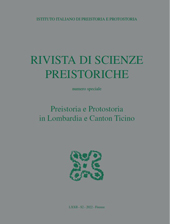Massi incisi e stele in Valtellina : una revisione
P. 355-365
In the last 15 years new fragments of stele have been brought to light in Valtellina, bringing the total number of monuments to 28 (found in 14 different sites). The local heritage has thus been enhanced in addition expanding the iconographic repertoire. Of these boulders/stele 18 show male imagery, 7 female, 3 are mixed and show the gender change of the monument. The present paper deals with the two famous stele Caven 1-2, where, due to new tracings, we could see that the gender attribution of these stele have been changed several times. In both Caven 1 and 2 the first phase is represented by a female imagery shown by a composition of several double spiral pendants.
The second phase of Caven 1 continues with the addition of a different female imagery (the so-called sun with three rays, double spiral pendants and combs), while the second phase of Caven 2 changes the gender of the stele, showing a male subject with a hammer axe associated with a ploughing scene with the plough pulled by two bulls with big horns, a unique case seen in Valtellina (while the theme is well known on the Valcamonica monuments). The third phase of Caven 1 shows the change of the gender, with the classic male representation of the III A1 style, the sun associated to the weaponry (axe, halberd, Remedello type daggers) and animals (two deer and one boar), together with the unique representation of a wagon pulled by two bulls with big horns.
This is a quite rare finding as the other two figures of wagon are known only in Lagundo 2 stele in Alto Adige and Cemmo 2 boulder in Valcamonica. The fourth phase of Caven 1 still belongs to the III A1 style showing animal figures and a Spilamberto dagger. The last (fifth) phase on Caven 1 is represented not only by the presence of a Bell Beaker dagger but also by group of animals in III A2 style, that show the typical curvilinear back. The third phase of Caven 2, instead, changes gender again going back to the female one with the sun with three rays, double spiral pendants and combs. In the fourth phase Caven 2 goes back to the male gender with an imagery similar to the one known in the third phase of Caven 1, a sun associated to the weaponry (axe, halberd, Remedello and Spilamberto type daggers) and one deer.
The last phase of Caven 2 belongs to the III A2 style, showing a Bell Beaker dagger and an ibex engraved on the side B of the stele. Probably to this phase belongs also a series of little cup-marks overlapped on several images of previous periods. 5 different phases alternate on both the stele: four of them can be attributed to the III A1 (3000-2500 BC), on the basis of the iconography, and only one to the III A2 (2500-2200 BC). Particularly interesting is the first phase constituted only by pendants. Pending new data and contexts that can clarify these chronological aspects, we can state that over the course of about five centuries the stele were engraved in four successive moments of the Copper 2 period, while the last intervention took place in the Bell Beaker period. [Publisher's text]
-
Articles from the same issue (available individually)
-
Information
DOI: 10.32097/1180
ISSN: 2282-457X


